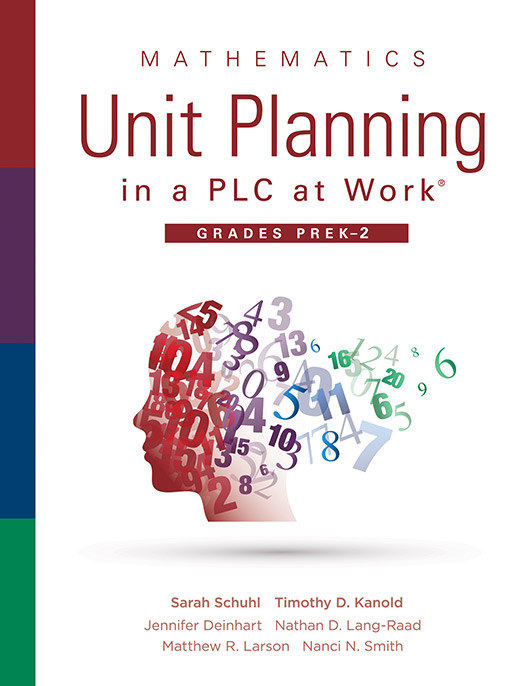Free Reproducibles
Mathematics Unit Planning in a PLC at Work®, Grades PreK–2
Bring a laser-like focus to the content preK–2 students need to learn in every unit throughout the year. This unit-planning resource enhances teacher collaboration through the PLC at Work process, increasing student learning in mathematics in early childhood education classrooms.
Benefits
- Understand how to collaboratively plan curriculum units in grades preK–2.
- Study the seven unit-planning elements and learn how to incorporate each in unit designs for early childhood education.
- Review the role of the PLC at Work®️ process in enhancing student learning and teacher collaboration.
- Observe four model units related to the foundations of addition and subtraction, one for each grade level.
- Receive tools and templates for effective unit planning in a professional learning community (PLC).
TABLE OF CONTENTS
Part 1: Mathematics Unit Planning and Design Elements
Chapter 1: Planning for Student Learning of Mathematics in Grades PreK–2
Chapter 2: Unit Planning as a Collaborative Mathematics Team
Part 2: Foundations of Addition and Subtraction Unit Examples, Grades PreK–2
Chapter 3: PreK Unit—Counting and Cardinality
Chapter 4: Kindergarten Unit—Addition and Subtraction to 10
Chapter 5: Grade 1 Unit—Addition and Subtraction to 20
Chapter 6: Grade 2 Unit—Multidigit Addition and Subtraction
Epilogue: Mathematics Team Organization
Appendix A: Create a Proficiency Map
Appendix B: Team Checklist and Questions for Mathematics Unit Planning
STUDY GUIDE
REPRODUCIBLES
Chapter 1
Chapter 2
- Figure 2.1: Mathematics Team Discussion Tool for Unit Planning
- Figure 2.2: Mathematics Unit Planning Rubric
- Figure 2.4: Team Protocol to Unwrap and Make Sense of Mathematics Standards
- Figure 2.5: Mathematics Unit Standards, Essential Learning Standards, and Daily Learning Targets
- Figure 2.6: Team Discussion Tool—Unit Calendar
- Figure 2.7: Protocol to Determine Prior Knowledge for a Mathematics Unit
- Figure 2.8: Protocol for Mathematics Vocabulary and Notations
- Figure 2.9: Protocol for Mathematics Tasks, Resources, Projects, and Activities
- Figure 2.10: Protocol for Mathematics Unit Tools and Technology
- Figure 2.11: Reflection and Notes Protocol for Mathematics Unit
Epilogue
Appendix A
- Figure A.1: Team Protocol to Organize Mathematics Standards
- Figure A.2: Team Protocol to Determine Grade-Level or Course Mathematics Units
Appendix B
Suggested Reproducibles From the Every Student Can Learn Mathematics Series
- Mathematics Assessment and Intervention in a PLC at Work
- Mathematics Instruction and Tasks in a PLC at Work
SUGGESTED RESOURCES
Books
- Bailey, K., & Jakicic, C. (2017). Simplifying Common Assessment: A Guide for Professional Learning Communities at Work. Bloomington, IN: Solution Tree Press.
- Buffum, A., Mattos, M., & Malone, J. (2018). Taking Action: A Handbook for RTI at Work. Bloomington, IN: Solution Tree Press.
- Dimich, N. (2015). Design in Five: Essential Phases to Create Engaging Assessment Practice. Bloomington, IN: Solution Tree Press.
- DuFour, R. (2015). In Praise of American Educators: And How They Can Become Even Better. Bloomington, IN: Solution Tree Press.
- DuFour, R., DuFour, R., Eaker, R., Many, T. W., & Mattos, M. (2016). Learning by Doing: A Handbook for Professional Learning Communities at Work (3rd ed.). Bloomington, IN: Solution Tree Press.
- Eaker, R., & Keating, J. (2015). Kid by Kid, Skill by Skill: Teaching in a Professional Learning Community at Work. Bloomington, IN: Solution Tree Press.
- Kanold, T. D., Barnes, B., Larson, M. R., Kanold-McIntyre, J., & Toncheff, M. (2018). Mathematics Homework and Grading in a PLC at Work. Bloomington, IN: Solution Tree Press.
- Kanold, T. D. (Ed.), Briars, D. J., Asturias, H., Foster, D., & Gale, M. A. (2013). Common Core Mathematics in a PLC at Work, Grades 6–8. Bloomington, IN: Solution Tree Press.
- Kanold, T. D., Kanold-McIntyre, J., Larson, M. R., Barnes, B., Schuhl, S., & Toncheff, M. (2018). Mathematics Instruction and Tasks in a PLC at Work. Bloomington, IN: Solution Tree Press.
- Kanold, T. D., & Schuhl, S. (2020). Mathematics at Work Plan Book. Bloomington, IN: Solution Tree Press.
- Kanold, T. D., Schuhl, S., Larson, M. R., Barnes, B., Kanold-McIntyre, J., & Toncheff, M. (2018). Mathematics Assessment and Intervention in a PLC at Work. Bloomington, IN: Solution Tree Press.
- Kanold, T. D., Toncheff, M., Larson, M.R., Barnes, B., Kanold-McIntyre, J. & Schuhl, S. (2018). Mathematics Coaching and Collaboration in a PLC at Work. Bloomington, IN: Solution Tree Press.
- Kramer, S. V., & Schuhl, S. (2017). School Improvement for All: A How-To Guide for Doing the Right Work. Bloomington, IN: Solution Tree Press.
- Norris, K., & Schuhl, S. (2016). Engage in the Mathematical Practices: Strategies to Build Numeracy and Literacy With K–5 Learners. Bloomington, IN: Solution Tree Press.
Websites
- Achieve the Core
- Achieve the Core, “Fluency Resources for Grade-Level Routines”
- Arcademics, “Alien Addition”
- DREME, “Counting Collections Overview”
- DREME, “Classroom Videos—Counting”
- Greg Tang Math, “Math Limbo”
- Illustrative Mathematics
- Math Playground, “Grand Slam Math”
- NAEYC, “Message in a Backpack™: Fun Ways to Build Your Child’s Literacy Skills While Doing Laundry Together”
- NCTM, “Five Frame”
- NCTM, “Okta’s Rescue”
- NCTM, “Ten Frame”
- Solution Tree, Engage in the Mathematical Practices, “Free Reproducibles”
- Toy Theater, “Virtual Manipulatives”
- Virginia Department of Education, “Mathematics Instructional Plans (MIPS)”

